| Listing 1 - 10 of 17 | << page >> |
Sort by
|
Book
ISBN: 0155507265 Year: 1988 Publisher: San Diego, Calif. Harcourt, Brace, Jovanovich
Abstract | Keywords | Export | Availability | Bookmark
 Loading...
Loading...Choose an application
- Reference Manager
- EndNote
- RefWorks (Direct export to RefWorks)
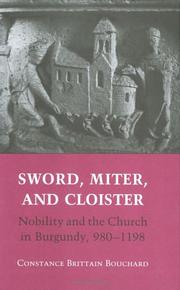
ISBN: 0801419743 9780801419744 Year: 1987 Publisher: Ithaca, N.Y. Cornell University Press
Abstract | Keywords | Export | Availability | Bookmark
 Loading...
Loading...Choose an application
- Reference Manager
- EndNote
- RefWorks (Direct export to RefWorks)
Christian church history --- anno 1100-1199 --- anno 1000-1099 --- Burgundy --- Monasticism and religious orders --- Monachisme et ordres religieux --- History --- Histoire --- Burgundy (France) --- Bourgogne (France) --- Church history --- Nobility --- Histoire religieuse --- Noblesse --- Social history --- 27 <44 BOURGOGNE> --- 27 <44> "10/11" --- -Monasticism and religious orders --- -Social history --- -Descriptive sociology --- Social conditions --- Sociology --- Monachism --- Monastic orders --- Monasticism and religious orders for men --- Monasticism and religious orders of men --- Orders, Monastic --- Religious orders --- Brotherhoods --- Christian communities --- Brothers (Religious) --- Friars --- Monks --- Superiors, Religious --- Noble class --- Noble families --- Nobles (Social class) --- Peerage --- Upper class --- Aristocracy (Social class) --- Titles of honor and nobility --- Kerkgeschiedenis--Frankrijk--BOURGOGNE --- Kerkgeschiedenis--Frankrijk--?"10/11" --- -Church history --- Church history. --- -Kerkgeschiedenis--Frankrijk--BOURGOGNE --- History. --- Orders, Religious --- Bourgogne-Franche-Comté (France) --- Nobility. --- Monasticism and religious orders - France - Burgundy - History - Middle Ages, 600-1500 --- Social history - Medieval, 500-1500 --- Nobility - France - Burgundy --- Burgundy (France) - Church history
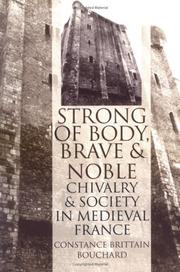
ISBN: 0801485487 0801430976 9780801485480 9780801430978 Year: 1998 Publisher: Ithaca : Cornell University Press,
Abstract | Keywords | Export | Availability | Bookmark
 Loading...
Loading...Choose an application
- Reference Manager
- EndNote
- RefWorks (Direct export to RefWorks)
Nobility --- Chivalry --- Noblesse --- Chevalerie --- History. --- Histoire --- France --- Civilization --- Civilisation --- History --- Noble class --- Noble families --- Nobles (Social class) --- Peerage --- Upper class --- Aristocracy (Social class) --- Titles of honor and nobility --- Manners and customs --- Orders of knighthood and chivalry --- Civilization, Medieval --- Courtly love --- Crusades --- Feudalism --- Heraldry --- Knights and knighthood --- 1000-1328 --- Nobility - France - History - To 1500 --- Chivalry - France - History - To 1500 --- France - Civilization - 1000-1328
Book
ISBN: 9780812246360 9780812290080 0812246365 Year: 2015 Publisher: Philadelphia, Pa University of Pennsylvania Press
Abstract | Keywords | Export | Availability | Bookmark
 Loading...
Loading...Choose an application
- Reference Manager
- EndNote
- RefWorks (Direct export to RefWorks)
Thinkers in medieval France constantly reconceptualized what had come before, interpreting past events to give validity to the present and help control the future. The long-dead saints who presided over churches and the ancestors of established dynasties were an especially crucial part of creative memory, Constance Brittain Bouchard contends. In Rewriting Saints and Ancestors she examines how such ex post facto accounts are less an impediment to the writing of accurate history than a crucial tool for understanding the Middle Ages. Working backward through time, Bouchard discusses twelfth-century scribes contemplating the ninth-century documents they copied into cartularies or reworked into narratives of disaster and triumph, ninth-century churchmen deliberately forging supposedly late antique documents as weapons against both kings and other churchmen, and sixth- and seventh-century Gallic writers coming to terms with an early Christianity that had neither the saints nor the monasteries that would become fundamental to religious practice. As they met with political change and social upheaval, each generation decided which events of the past were worth remembering and which were to be reinterpreted or quietly forgotten. By considering memory as an analytic tool, Bouchard not only reveals the ways early medieval writers constructed a useful past but also provides new insights into the nature of record keeping, the changing ways dynasties were conceptualized, the relationships of the Merovingian and Carolingian kings to the church, and the discovery (or invention) of Gaul's earliest martyrs.
Historiography --- Christian hagiography --- Genealogical literature --- Middle Ages --- Memory --- Historiographie --- Hagiographie chrétienne --- Généalogie --- Moyen Age --- Mémoire --- History --- Historiography. --- History. --- Histoire --- Documentation --- France --- Sources. --- Sources --- Hagiographie chrétienne --- Généalogie --- Mémoire --- Christian church history --- History as a science --- Christian spirituality --- History of France --- Genealogy. Heraldy --- anno 500-1499 --- Historiography - France - History - To 1500 --- Christian hagiography - History - To 1500 --- Genealogical literature - France - History - To 1500 --- Middle Ages - Historiography --- Memory - History --- France - History - To 987 - Historiography --- France - History - Medieval period, 987-1515 - Historiography --- France - History - To 987 - Sources --- France - History - Medieval period, 987-1515 - Sources
Book
ISBN: 0915651076 9780915651078 Year: 1998 Volume: 102 Publisher: Cambridge Medieval academy of America
Abstract | Keywords | Export | Availability | Bookmark
 Loading...
Loading...Choose an application
- Reference Manager
- EndNote
- RefWorks (Direct export to RefWorks)
Monasticism and religious orders --- Cartularies --- Monachisme et ordres religieux --- Cartulaires --- History --- Sources --- Histoire --- St.-Marcel-lès-Chalon (Monastery) --- Burgundy (France) --- Bourgogne (France) --- Church history --- Sources. --- Histoire religieuse --- St.-Marcel-les-Chalon (Monastery) --- 271.1 <44 St.-MARCEL-LES-CHALON> --- -Monachism --- Monastic orders --- Monasticism and religious orders for men --- Monasticism and religious orders of men --- Orders, Monastic --- Religious orders --- Brotherhoods --- Christian communities --- Brothers (Religious) --- Friars --- Monks --- Superiors, Religious --- Benedictijnen--Frankrijk--St.-MARCEL-LES-CHALON --- -Saint-Marcel-lès-Chalon (Monastery) --- -Burgundy (France) --- -Church history --- -Benedictijnen--Frankrijk--St.-MARCEL-LES-CHALON --- -History --- 271.1 <44 St.-MARCEL-LES-CHALON> Benedictijnen--Frankrijk--St.-MARCEL-LES-CHALON --- St.-Marcel-lès-Chalon (Monastery) --- Monachism --- Orders, Religious --- Saint-Marcel-lès-Chalon (Monastery) --- Bourgogne-Franche-Comté (France) --- Monasticism and religious orders - France - History - Middle Ages, 600-1500 - Sources --- Saint-Marcel-lès-Chalon --- Burgundy (France) - History - Sources --- Burgundy (France) - Church history - Sources
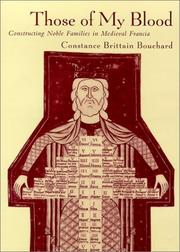
ISBN: 0812235908 9780812235906 9786613211484 1283211483 081220140X 0585436193 Year: 2001 Publisher: Philadelphia : ©2001 University of Pennsylvania Press,
Abstract | Keywords | Export | Availability | Bookmark
 Loading...
Loading...Choose an application
- Reference Manager
- EndNote
- RefWorks (Direct export to RefWorks)
For those who ruled medieval society, the family was the crucial social unit, made up of those from whom property and authority were inherited and those to whom it passed. One's kin could be one's closest political and military allies or one's fiercest enemies. While the general term used to describe family members was consanguinei mei, "those of my blood," not all of those relations-parents, siblings, children, distant cousins, maternal relatives, paternal ancestors, and so on-counted as true family in any given time, place, or circumstance. In the early and high Middle Ages, the "family" was a very different group than it is in modern society, and the ways in which medieval men and women conceptualized and structured the family unit changed markedly over time. Focusing on the Frankish realm between the eighth and twelfth centuries, Constance Brittain Bouchard outlines the operative definitions of "family" in this period when there existed various and flexible ways by which individuals were or were not incorporated into the family group. Even in medieval patriarchal society, women of the aristocracy, who were considered outsiders by their husbands and their husbands' siblings and elders, were never completely marginalized and paradoxically represented the very essence of "family" to their male children. Bouchard also engages in the ongoing scholarly debate about the nobility around the year 1000, arguing that there was no clear point of transition from amorphous family units to agnatically structured kindred. Instead, she points out that great noble families always privileged the male line of descent, even if most did not establish father-son inheritance until the eleventh or twelfth century. Those of My Blood clarifies the complex meanings of medieval family structure and family consciousness and shows the many ways in which negotiations of power within the noble family can help explain early medieval politics.
Nobility --- Knights and knighthood --- History --- 929.7 --- Adel. Eretitels --- 929.7 Adel. Eretitels --- Knighthood --- Civilization, Medieval --- Chivalry --- Heraldry --- Orders of knighthood and chivalry --- Noble class --- Noble families --- Nobles (Social class) --- Peerage --- Upper class --- Aristocracy (Social class) --- Titles of honor and nobility --- Nobility - France - History - To 1500. --- Nobility - France - Genealogy. --- Knights and knighthood - France - History - To 1500. --- History. --- Medieval and Renaissance Studies.
Book
ISBN: 0910956677 9780910956673 Year: 1979 Volume: 5 Publisher: Cambridge Medieval academy of America
Abstract | Keywords | Export | Availability | Bookmark
 Loading...
Loading...Choose an application
- Reference Manager
- EndNote
- RefWorks (Direct export to RefWorks)
Bishops --- History --- Catholic Church. --- -Archbishops --- Clergy --- Major orders --- Metropolitans --- Orders, Major --- Chaplains, Bishops' --- Episcopacy --- -Major orders --- Catholic Church. Diocese of Auxerre (France) History --- -History --- -Catholic Church. Diocese of Auxerre (France) History --- Archbishops --- Bishops - France - Auxerre - History - To 1500. --- Auxerre --- Evêques
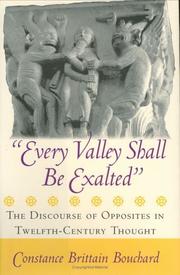
ISBN: 0801440580 Year: 2003 Publisher: Ithaca London : Cornell University Press,
Abstract | Keywords | Export | Availability | Bookmark
 Loading...
Loading...Choose an application
- Reference Manager
- EndNote
- RefWorks (Direct export to RefWorks)
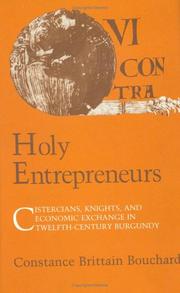
ISBN: 9780801475252 0801425271 9780801425271 0801475252 1501721038 Year: 2018 Publisher: Ithaca, NY : Cornell University Press,
Abstract | Keywords | Export | Availability | Bookmark
 Loading...
Loading...Choose an application
- Reference Manager
- EndNote
- RefWorks (Direct export to RefWorks)
The twelfth century was characterized by intense spirituality as well as rapid economic development. Drawing on unprecedented research, Constance Brittain Bouchard demonstrates that the Cistercian monks of Burgundy were exemplary in both spheres. Bouchard explores the web of economic ties that linked the Cistercian monasteries with their secular neighbors, especially the knights, and reaches some surprising conclusions about Cistercian attitudes.
Commerce --- Nobility --- Noble class --- Noble families --- Nobles (Social class) --- Peerage --- Upper class --- Aristocracy (Social class) --- Titles of honor and nobility --- History --- Economic conditions --- Cistercians --- Zisterzienser --- White Monks --- Bernardines (Cistercian) --- Order of Cîteaux --- Cîteaux, Order of --- S. Ordo Cisterciensis --- Sacer Ordo Cisterciensis --- Ordo Cisterciensis --- Cisztercita Szerzetes --- Cisterciensi --- Řád cisterciáků --- Cisterciácký řád --- Cisterciens --- Trappists --- Economic conditions. --- Burgundy (France) --- Bourgogne (France) --- History. --- Knights and knighthood --- Noblesse --- Chevaliers et chevalerie --- Conditions économiques --- Histoire --- Bourgogne-Franche-Comté (France) --- Religious Studies. --- HISTORY / Medieval. --- Nobility - France - Burgundy - Economic conditions - History --- Commerce - History - Medieval, 500-1500

ISBN: 1501716646 1501716654 9781501716652 0801440580 1501713647 9780801440588 9781501713644 9781501716645 Year: 2017 Publisher: Ithaca, NY
Abstract | Keywords | Export | Availability | Bookmark
 Loading...
Loading...Choose an application
- Reference Manager
- EndNote
- RefWorks (Direct export to RefWorks)
In high medieval France, men and women saw the world around them as the product of tensions between opposites. Imbued with a Christian culture in which a penniless preacher was also the King of Kings and the last were expected to be first, twelfth-century thinkers brought order to their lives through the creation of opposing categories. In a highly original work, Constance Brittain Bouchard examines this poorly understood component of twelfth-century thought, one responsible, in her view, for the fundamental strangeness of that culture to modern thinking.Scholars have long recognized that dialectical reasoning was the basic approach to philosophical, legal, and theological matters in the high Middle Ages. Bouchard argues that this way of thinking and categorizing-which she terms a "discourse of opposites"-permeated all aspects of medieval thought. She rejects suggestions that it was the result of imprecision, and provides evidence that people of that era sought not to reconcile opposing categories but rather to maintain them. Bouchard scrutinizes the medieval use of opposites in five broad areas: scholasticism, romance, legal disputes, conversion, and the construction of gender. Drawing on research in a series of previously unedited charters and the earliest glossa manuscripts, she demonstrates that this method of constructing reality was a constitutive element of the thought of the period.
Opposition, Theory of --- Contrariety --- Philosophy --- Polarity --- Psychology --- History --- France --- Intellectual life
| Listing 1 - 10 of 17 | << page >> |
Sort by
|

 Search
Search Feedback
Feedback About UniCat
About UniCat  Help
Help News
News